Have LinkedIn's AI sales bros convinced you that robots could replace you? Is the learning curve of adding AI to your workflow looming in the back of your mind every time you make your to-do list? Are you wondering if ChatGPT can actually be useful for your job or if it's just another gimmick?
We get it—this whole AI thing is overwhelming. So let’s simplify it.
Right now, there are two paths you can take as a salesperson working in 2025:
Path #1: You wait for your company to adopt AI sales tools and techniques. (Because sooner or later, they totally will.) This'll probably take literal years as you wait for someone at the top to realize the potential of what AI can do, wait longer for them convince the rest of your executive team to implement the changes, and then wait even longer than that for IT to actually implement the tools and get them up and running. (Oh, and while you wait, you better believe some of your scrappy competitors will start using AI in their sales workflows to go after your customers.)
Path #2: You decide to be proactive. You start using free AI tools today—and you begin to see the practical ways they can help you close more deals. (They're listed below!) Heck, you could even show the rest of your team how useful they are—and convince your boss that it's time to get serious about investing in the future of sales. Because no matter what your tech stack is or how overbearing your IT department seems, the reality is this: you can start using AI tools to sell more to prospects and customers today.
We're here to eliminate whatever AI anxiety you might have. Step away from the noise and focus on what you can put into action. This guide is full of practical plays that you can start using right now to help you close more deals and reduce your soul-sucking admin work. But before we get to those, let's talk about the current state of AI in sales today.

Why use AI in sales?
A tale of two account executives: AI-powered Maisie vs. old-school David
Maisie and David are competing to meet their quarterly sales goals. Maisie is skeptical of AI, but she chooses to embrace it because she’s worried the higher-ups will try to replace her with it. She’s all for anything that can make her workday feel less soul-crushing.
David, on the other hand, thinks that a salesperson relying on AI to do their work is like a horror movie where the robots take over, and everyone else just becomes extras running for their lives. Let’s follow them around for a day and see who’s enjoying their job more, shall we?

Emails
David is not exactly thrilled about embracing AI in sales. It feels like another way for the higher-ups to monitor his every move and squeeze even more productivity out of him. So he spends 11 hours a week on email alone. He sifts through the messages, prioritizes them based on urgency, and responds to each one individually.
Maisie lets AI handle all the mind-numbing tasks so she can spend her time on more important things like binge-watching her favorite shows and perfecting hiding her eye rolls on Zoom. She spends around eight hours a week on email, quickly responding to any urgent inquiries or follow-ups using AI prompt templates and an autocomplete extension.
TL;DR: AI can save you 3 hours a week on email alone.
Prospecting
David spends upwards of ten hours a week on cold calls and searching for potential prospects through directories, industry publications, and social media platforms. Once he finds potential leads, David researches each prospect individually and gathers information about them. He enters his prospects into his CRM manually and hopes his boss won’t ask him to work overtime again this Friday while he’s at it.
Maisie’s GPT agent scrapes social media platforms, company databases, and online directories to identify potential leads that match her target customer profile. Her pizza got stolen from the breakroom fridge, but it doesn’t matter. She has plenty of time to take a leisurely stroll to the local taco stand for a little treat instead. Each week, the GPT agent generates a list of qualified leads; she brings in 50% more leads than David.
TL;DR: AI can bring in 50% more leads than you can on your own.
Sales meetings
Maisie avoids pointless meetings; instead, you’ll find her napping in her cubicle. But if it’s time to close a deal, Maisie brings in an AI presentation maker so her custom sales pitch hits the mark every time – all her clients say she’s practically a mind-reader. The software she uses for video calls transcribes and analyzes the meeting in real-time, so when she’s done, she can objectively tell how the prospect was feeling and compose her follow-up accordingly.
Before his sales call, David stress eats cold pizza he found in the breakroom fridge. He spends an hour or two prepping for each meeting by researching the prospect and making customized sales presentations. During the meeting, he flies solo, relying on his own knowledge and experience to deliver the pitch and handle objections.
TL;DR: You don’t have to go it alone in sales meetings. AI tools are here to help you increase your conversions with sentiment analysis and generative presentations.
Follow-ups
When David follows up with prospects, he might copy and paste a template, but he mainly works independently. David spends 13 hours a week on negotiations and follow-up communications, in person, over the phone, or email. His negotiation skills and experience were honed through direct sales conversations with customers.
Maisie enjoys coming to work because her AI assistant that can handle all the annoying customer inquiries so she can sip her coffee in peace. Her AI voice tool and email prompt templates help her speed through her follow-ups and cold calls. She spends about four hours a week on cold calls. She consults a chatbot to predict what her client’s objections might be – it's entertaining to fight with a robot, plus her conversion rates are up.
TL;DR: AI can reduce your time on sales calls by up to 60%.
Updating CRM
Throughout the day, David updates his CRM with new leads, prospect information, meeting notes (which he took himself), and deal progress. He’s constantly handling administrative tasks like managing his calendar, answering emails, and preparing reports for sales meetings or performance reviews.
Maisie’s AI tools automatically update her CRM based on the customer interactions she’s had that day and data scraped from their public profiles online. Maisie can make data-driven decisions, identify upselling or cross-selling opportunities, prioritize her efforts, and personalize emails on autopilot using AI with her CRM.
TL;DR: AI can help you escape the monotonous grind and find some meaning in your job again.
Sales Goals
David’s sales goals are hit-and-miss. He occasionally reaches his quarterly targets, but usually only when he can work a few extra hours. He realizes that if he used AI, he might actually have a shot at work-life balance. And by work-life balance, we mean more time for his passion project: doing as little as possible. But he’s too worried about getting replaced by a robot with better people skills.
Maisie meets her sales goals almost every quarter. She closes more upsells and cross-sells than anyone else on her sales team. She totally attributes her increased success to having more time to talk to existing and prospective customers face-to-face since his AI is taking the heavy lifting of non-sales tasks off her hands.
TL;DR: AI will increase your sales performance by freeing up to time for you to focus on revenue-increasing tasks.
3 Benefits of AI in sales (A.K.A. How robots help you sell more)
You’re expected to make up-sells and cross-sells, bring in new leads, and meet your quarterly sales goals—who has enough time for all of that? Add learning AI to the mix, and you’re definitely dreaming about escaping to a desert island now, right?
You already find yourself wishing you could clone yourself just to keep up with all the pointless tasks and reports that eat up your time. But you might have enough time for it all if you start embracing AI today. AI automations can lift sales reps efficiency by at least 27%. If you work a 40-hour week, that’s 10.8 hours a week saved. Imagine if your CRM updated itself. What if your robot assistant found your sales leads, and all you had to do was say yes or no to them? If that same robot found all the nitty-gritty information you needed about them? How would you feel if you never had to make the initial cold call again?
“AI is empowering sales reps with data-driven insights about consumer preferences and behaviors, enabling hyper-personalization in sales methods. This helps you personalize your approach and build stronger relationships. You’ll be able to grasp clients' demands better, improving customer satisfaction and sales.”

Consider AI like your unpaid intern, except it’s probably more professional than the local college kid who spends half their day on TikTok watching crypto videos. It’s here to help you save time and make data-informed decisions. You could be increasing your lead gen efforts by up to 50% and decreasing call times by 60% with the power of AI. Here’s how.
Expands your reach
AI helps salespeople reach more customers and close more deals. New data from Magical shows that, on average, salespeople using AI send 20% more outreach messages in a week.

AI’s ability to personalize customer interactions is one of its most useful functions. It can collect data about customer preferences and behavior by analyzing call transcripts, emails, and social media like Twitter or LinkedIn. You can tailor your approach and create custom experiences that genuinely resonate with customers in less time.
Pete Huang, creator of The Neuron Daily newsletter, agrees:
"You'll be able to know more about each account and prospect and use AI to find opportunities that you normally wouldn’t have discovered previously. This will be evident in things like call notes — AI will help you analyze your call much more thoroughly than you were able to before."

It's not just about sales—AI can also help you anticipate your customer’s needs and offer solutions that build trust and loyalty. Plus, by automating tedious tasks like lead generation and data entry, AI frees up time for you to focus on more important stuff like closing deals and building relationships.
Maximizes selling time
Time spent selling is the new key metric. Using AI strategically allows you to reduce the time spent on non-revenue-producing activities so you can spend more time selling.
On average, salespeople devote only 32% of their time to selling and 68% to non-revenue-producing activities. If we assume you’re working 40 hours a week. That’s 12.8 hours selling and 27.2 hours not selling.
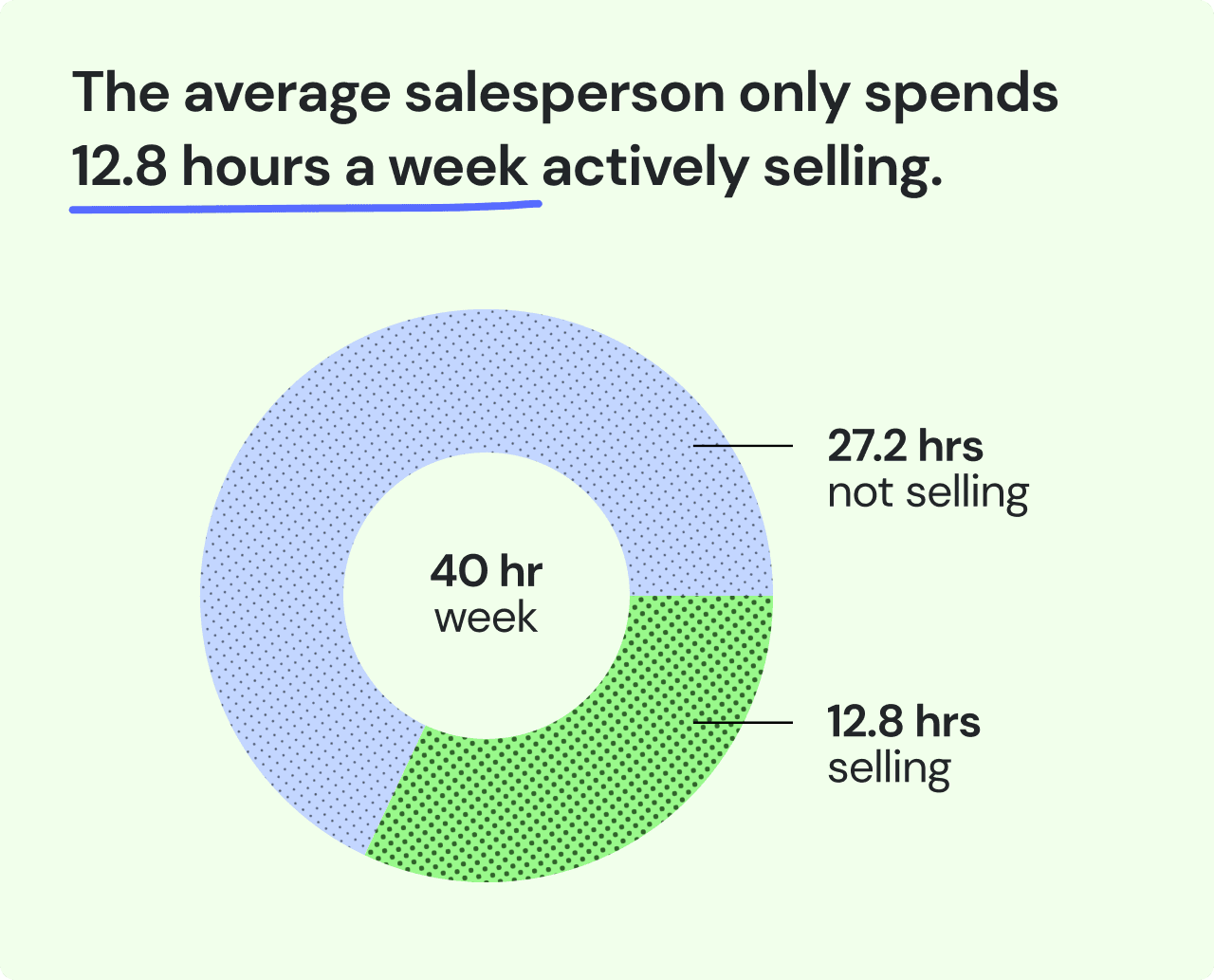
Magical alone saves salespeople at least 5 hours a week on admin tasks and repetitive messaging. That means 17.8 hours are spent selling—think of how many more deals you could close with an extra five hours every single week.
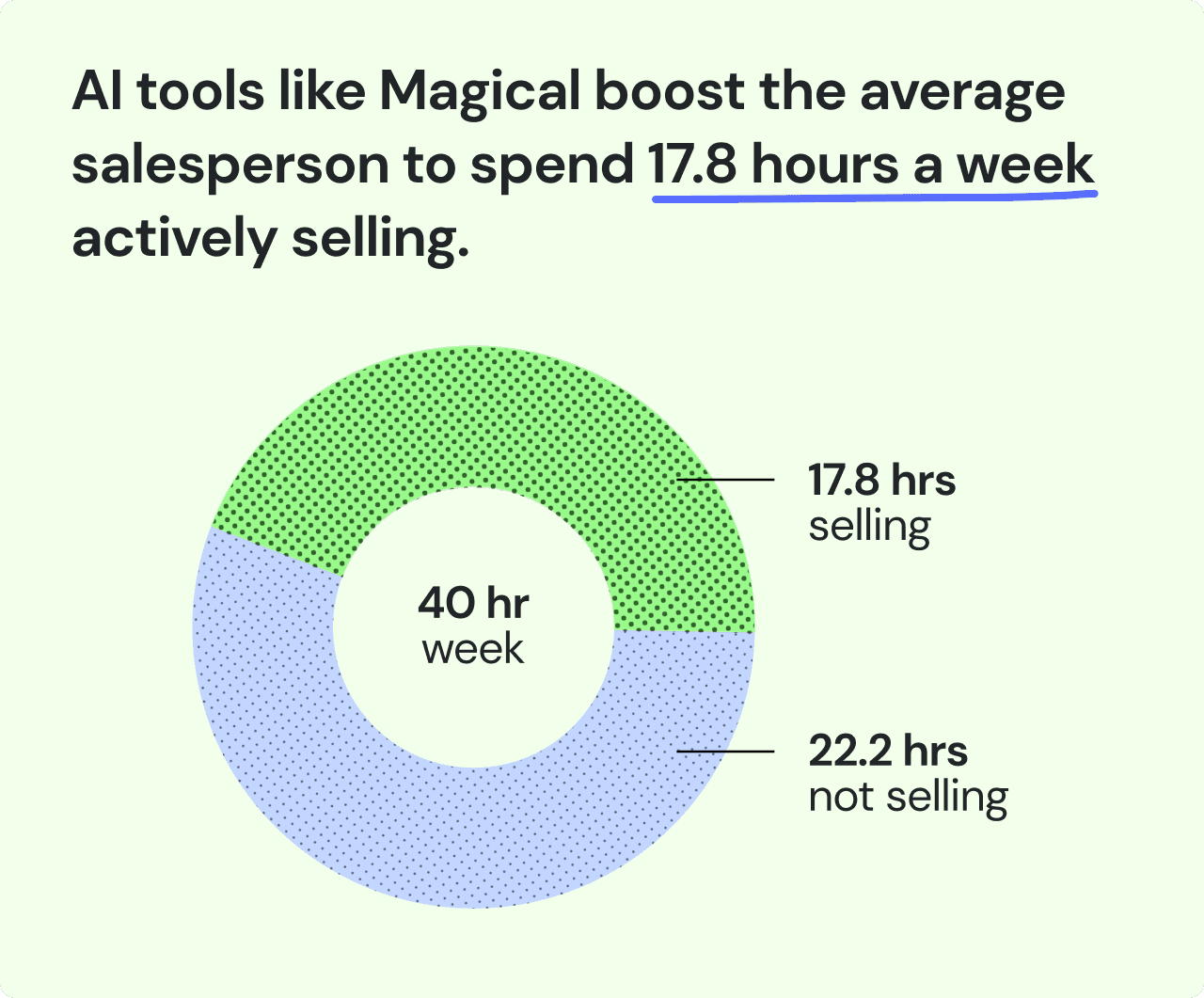
“AI will substantially alter sales roles by boosting effectiveness and extending the limits of what's possible while allowing previously time-consuming tasks and research to be completed with just a few keystrokes."

Avoids the bureaucracy
The best part about AI? Anyone can use it. There are hundreds of free or affordable AI tools. We’re in the most accessible era of software evolution ever. You don’t even have to download software to your computer to use it, extensions and browser-based apps do most of the heavy lifting—move over, legacy platforms.
In the past, you’d probably have to wait for your IT department to implement new software. Not anymore—with free Google Chrome extensions like Magical being easy for anyone to add to their browser in a matter of minutes.
TL;DR: AI is making it easier for salespeople to do their jobs better, and proactive salespeople who leverage these tools are leading the pack.
3 challenges of AI in sales (A.K.A. how to avoid AI confusion)
AI is changing your job; there’s no denying it anymore. It’s harder than ever to get the attention of prospects. With thousands of new AI applications released this year and the rise of automated personalization, you need to know which tools to use and how to make your personalization more unique.
Huang knows the struggle all too well, “Remember that humans come first. The world is flooded with people taking too blunt of an approach and spamming everyone's inboxes with the same generic AI-created emails. You have an opportunity to stand out by striking exactly the right use of AI in your daily work!”
AI can revolutionize your sales process, making your job easier and more productive. But it isn’t without its negatives, of course. Here are three things salespeople struggle with when it comes to AI.
It’s the end of personalization as we know it (and I feel fine)
AI speeds up personalization, which is incredibly useful. But as people use it more, you’ll need to go deeper if you want to be successful as a salesperson. Even without AI, 95% of salespeople personalize outreach messages “frequently.”

People don’t want generic templated AI-created emails shouting out their company’s recent developments. They want something even more personal but not to the point of being creepy.
The emails that get prospects to book a call are personalized within the first 200 words and reference deep personal connections. The most compelling personalizations are recent life changes, congratulations on specific recent achievements, going to the same college, a sports team someone is interested in, having grown up in the same town, or local landmarks.
I know what you’re thinking—but you just told me to use AI for personalization! And we stand by that. Rather than relying on templates that get filled completely by AI, you’ll still need to take the time to pick the right personalization and set up your AI tools to dig deeper. If you want to reliably increase response rates by up to 493%, AI will save you time, but you can’t rely on it solely just yet.
It takes the average salesperson five minutes to personalize an email. With AI, you’ll be able to do it in one minute or less and leverage deeper personal connections than you could without it.
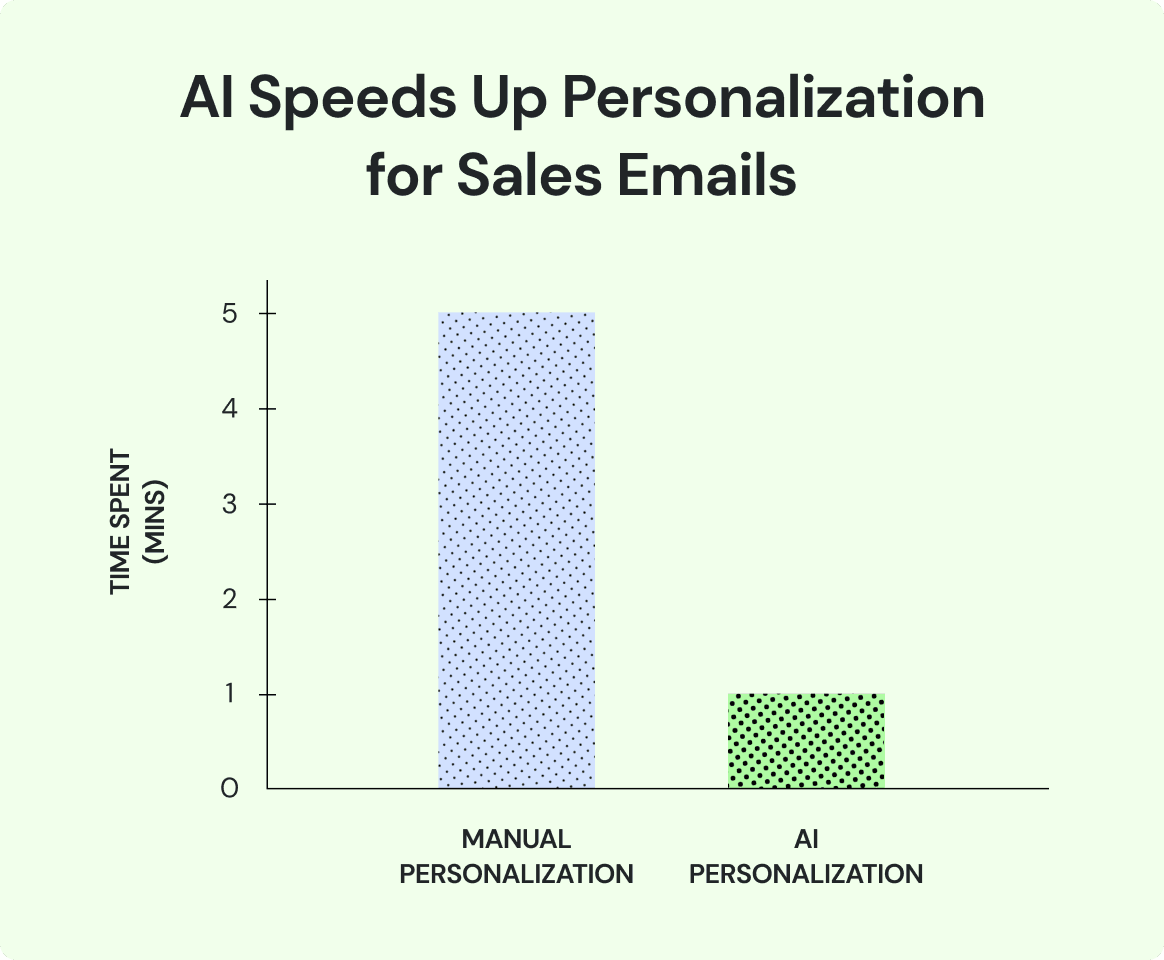
Too many options
Over 5,000 AI tools have been launched in 2023 so far. To put it mildly, that’s daunting. Where do you even begin finding the right tool for you? Which ones will make your job easier, and which ones will just add unnecessary complexity to the sales process?

It's not just the sheer number of tools that's the problem; it's also the lack of clarity around which tools are best suited to which use cases. With so many options available, it can be hard to separate the truly useful options and which ones are just hype.
Don’t worry—we know why you’re here. Don’t point out a problem without offering a solution! Later in this guide, we’ll recommend our top picks for AI software that salespeople can use to maximize their time.
Chatbots can help automate routine tasks like answering customer inquiries, freeing you up to focus on more important activities. Predictive analytics tools can help you find opportunities for growth and stay ahead of the competition. Other AI tools can help you analyze customer behavior and preferences through social media and transcripts from your call—all while updating your CRM for you.
AI is not always accurate
Eight out of ten sales professionals say they are most worried about AI tools' accuracy. We’re still in the early days of generative AI. You shouldn’t totally trust it. It won’t always be accurate at this stage.

Sure, we’ll probably look back on this in ten years and think, “Wow, remember when AI was the Wild West?” But for now, we still have to fact-check everything that comes out of ChatGPT, even once it does get internet connectivity.
Since a majority of generative text AI applications are created on GPT, this doesn’t only apply to ChatGPT. Every AI app out right now requires fact-checking and a once-over by humans before it’s visible for customer-facing purposes.
TL;DR: AI has changed the job of a salesperson, making it even harder to get the attention of prospects. And salespeople aren’t sure which tools they should be using.
7 sales plays only possible with AI

If you had a dollar for every hour wasted on mind-numbing tasks, you could retire and never have to sell anything again! We wish that’s not how it worked. But until the day when someone can make AI do that, why not try a “magic” trick instead?
You don’t need to clone yourself to get more out of your workday. You just need to learn some simple AI tools you can use without even talking to your IT department.
AI is making entirely new sales plays possible, and you can start putting these into action today. Here are seven ways to bring AI into your sales workflow to increase your productivity and conversions. Set these up and save your brainpower for the important stuff.
1) The Instant Rapport Builder
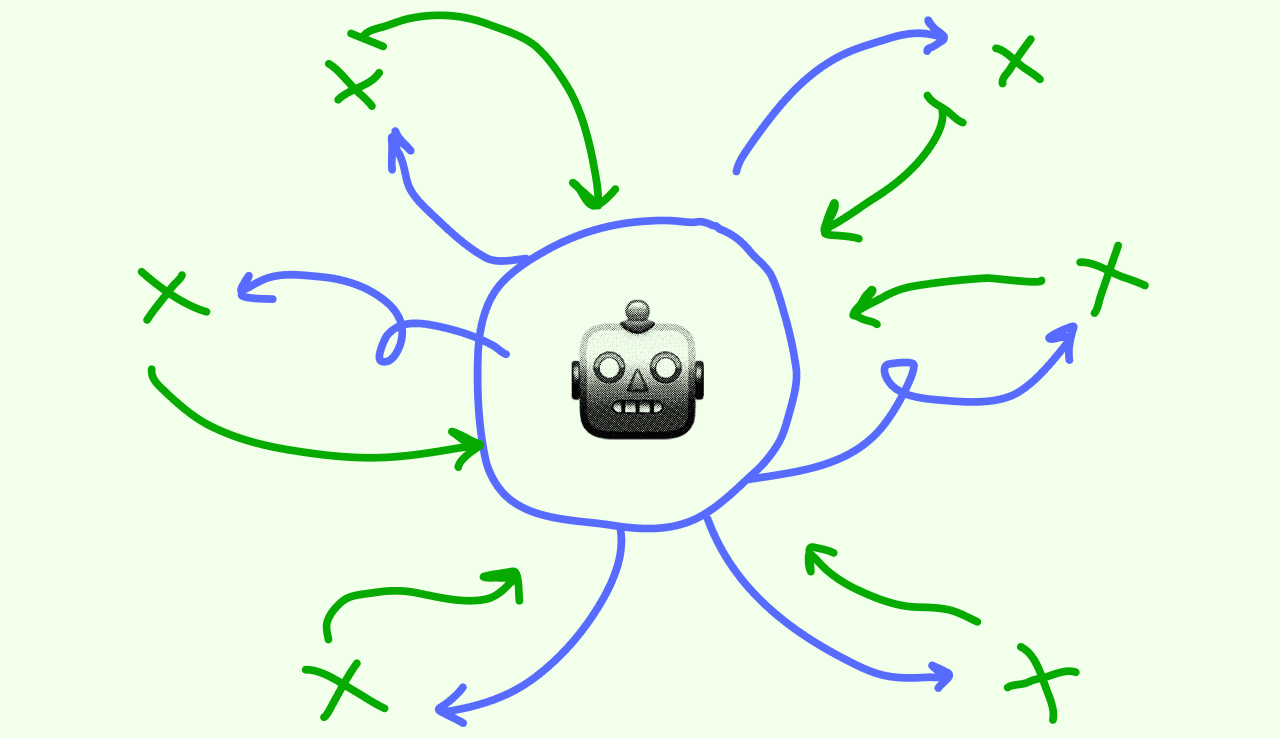
Situation: Discovery Call
The most successful salespeople will need to go deeper with personalization, calling out details that actually matter to the lead. Let the AI maximize your time by warming them up with surface-level personalization. Then, use the extra time you saved by using AI to dig even deeper and really speak to the lead’s unique needs.
The Play:
Step 1: Before hopping on a discovery call with a lead, find their most relevant and active social profile (e.g., LinkedIn, Twitter, or Instagram).
Step 2: Use Phantom Buster to scrape their activity.
Step 3: Paste their activity history into ChatGPT.
Step 4: Ask ChatGPT to summarize the top 5 things the lead cares about the most.
Step 5: Use these as your conversation openers in your discovery call.

The Benefit:
You’ll be able to go beyond their current interests or whatever they have been posting recently and get a fuller idea of what they care more deeply about.
“After the AI warms up the leads and gathers key insights, the sales representative continues the conversation, using the AI's data to create trust and rapport with each decision-maker.”

The Tool:
Phantom Buster is a cloud-based data scraping and automation tool. It also allows you to generate leads on LinkedIn, Sales Navigator, Instagram, Facebook, and Twitter.
2) The Alley-Oop
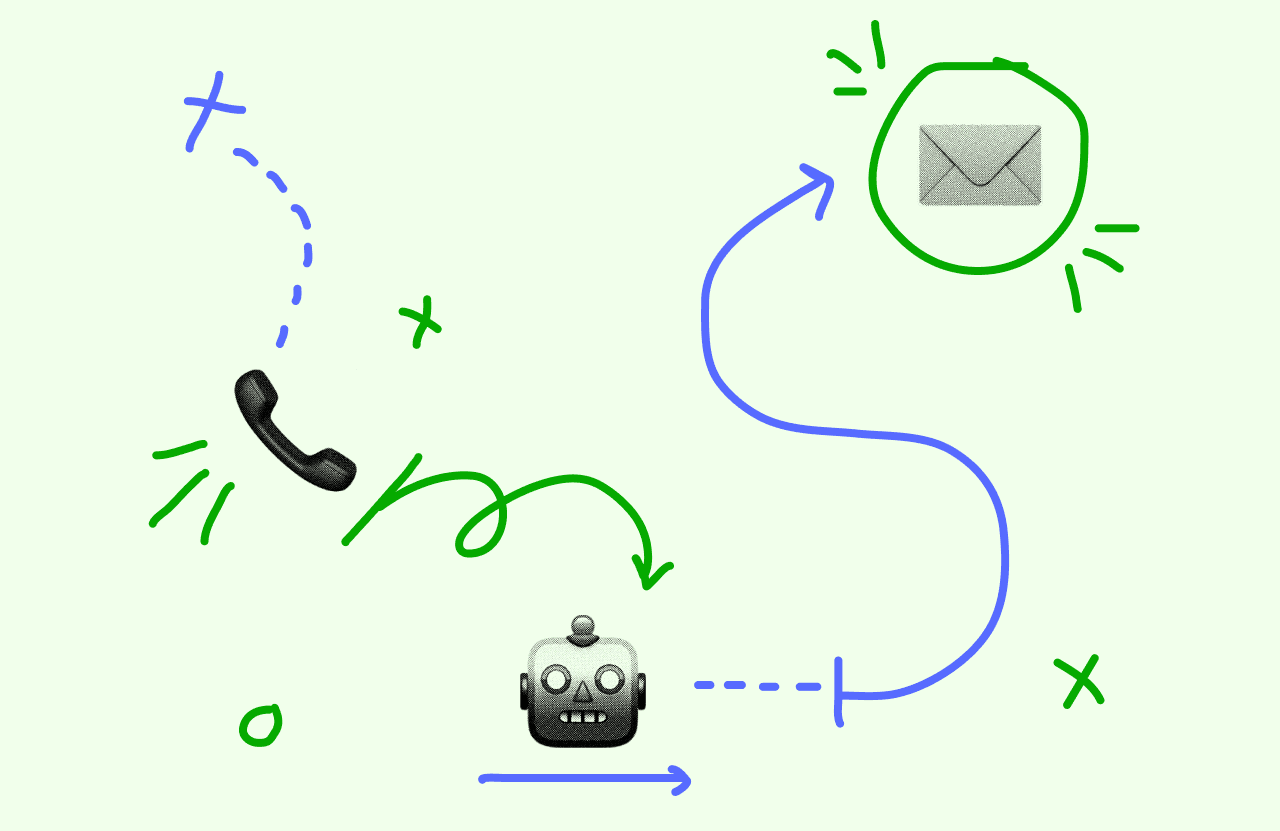
Situation: Follow Up After Discovery Call
When you’re immersed in a sales call, it can be hard to see the whole picture. You get caught up in your scripts and absorbing information that it’s easy to miss deeper emotional cues. Plus, you’re not a mind reader.
You’re left wracking your brain for a way to make your follow-up emails empathetic. You don’t want misinterpretations, missed concerns, or failed rapport to make you miss out on a sale.
But you can crack the code without going back in time. AI-powered tools can analyze vocal patterns, tone, and keywords, revealing what's beneath the surface. Armed with insights, you can now tailor your follow-up for maximum impact.
The Play:
Step 1: After your call with a lead, download the transcript.
Step 2: Plug your transcript into OneAI’s analysis tool.
Step 3: Turn on the insights for “sentiment” and “emotion” by dragging their icons up to the “outputs” box.
Step 4: Use the insights to quickly get a sense of how the prospect was really feeling on the call.
Step 5: In your follow-up email, leverage their emotions and sentiment to close the deal.

The Benefit:
You’ll quickly and easily get a read on what your prospects were feeling and pick up on sentiments that you might’ve missed live on the call. This makes your follow-up all the more powerful.
“AI is the best point guard out there. Why? Because it has a better vision of the court than you do. After the call is done, it’ll tell you the person’s sentiment. Were they interested? Were they not interested? Did they have questions or concerns? You’ll know whether they were hesitant or confident because the AI gives you that pass in the air so you can slam dunk it home.”

The Tool:
OneAI Language Studio is a no-code tool for AI ideation and experimentation. It’s capable of more than 27 natural language processing functions. Our favorite function? The sentiment analysis tool gives you insights into how someone was feeling based on a text transcript.
3) The Cold Call Sidekick

Situation: Cold-Calling Leads
You’re constantly seeking ways to maximize your efficiency and effectiveness during sales calls. In this pursuit, you’ve realized that personalization at scale is essential but often time consuming.
But you’re spending upwards of ten hours a week dialing numbers, leaving voicemails, and engaging in repetitive conversations. Here’s another way AI can step in so you can focus your energy on higher-value activities like closing deals.
The Play:
Step 1: Set up an AI voice clone using a tool like ElevenLabs’s Prime Voice AI.
Step 2: Use ElevenLabs to record the audio message in your own voice.
Step 3: Use voice mail templates for different scenarios - be transparent that this is a robot speaking, not you.
Step 4: Quickly personalize them based on your lead and situation.
Step 5: Start using your growing library of voice mails to scale your message output.
Want to take this play to the next level? Create a full phone bot using a tool like ChatCompose that can understand prompts. Like all AI chatbots, be aware of these risks and take appropriate precautions. Review the app's privacy policy and make sure that it doesn’t violate any of your company’s security rules. Ethically, you should always let prospects know upfront that they are speaking with a bot.

The Benefit:
Creating a capable AI bot that scales will allow you to make more money and save time. It’ll impress your boss, too. You can even use the data from your bot’s chats to auto-update your CRM and provide notes at the end of a call.
“Replace yourself with an AI Chatbot as quickly as you can. Best-case scenario, you’ll be able to make TONS more on your 15% commission if you get it working. Worst-case scenario, if you don't get it to work for you, you'll at least have a clear sense of what the state of AI in sales is and what the challenges are to replace yourself.”

The Tool:
Prime Voice AI is ElevenLab’s generative speech tool. It’s designed to help creators and publishers create spoken audio in any voice and style. ChatCompose offers you the ability to create your own sales and support chatbot. You can design personalized sales and conversation scripts and deploy your chatbots across various communication channels.
4) The Magic Deck

Situation: Demo or Sales Presentation
There’s nothing like acing that sales deck and showing a potential customer that you understand their unique situation and are focused on solving their specific problem. You overcome their objections with ease when you know exactly what they’re worried about.
But you’re not a mind-reader. And how can you perfectly customize every single pitch deck? We get it. It sounds time-consuming. But it’s not anymore. You can customize and personalize a sales deck in mere minutes with AI. Here’s how.
The Play:
Step 1: At the beginning of the call, ask them what they’re most concerned about.
Step 2: Use Tome to create new slides in the deck based on their response.
Step 3: Stall for 1-2 minutes while Tome generates.
Step 4: Start the presentation. Now it looks like you read their mind and prepped a deck to tackle exactly what they were wondering about.

The Benefit:
Customizing your sales deck based on the customer’s concerns during their call allows you to handle objections with ease and show them you’ve been paying attention. You’ve gone above and beyond to make the sale for them—it’s almost like you read their mind.
“It doesn't matter how much research you do upfront to build rapport, it matters how much you can actually help the prospect and how efficiently you narrow in on their problem and give them an affordable, easy solution to solve it.”

The Tool:
Tome creates presentations with a story, audio, and visual in minutes using the power of AI. I can help you level up your sales pitch with the power of storytelling.
5) The Achilles Deal
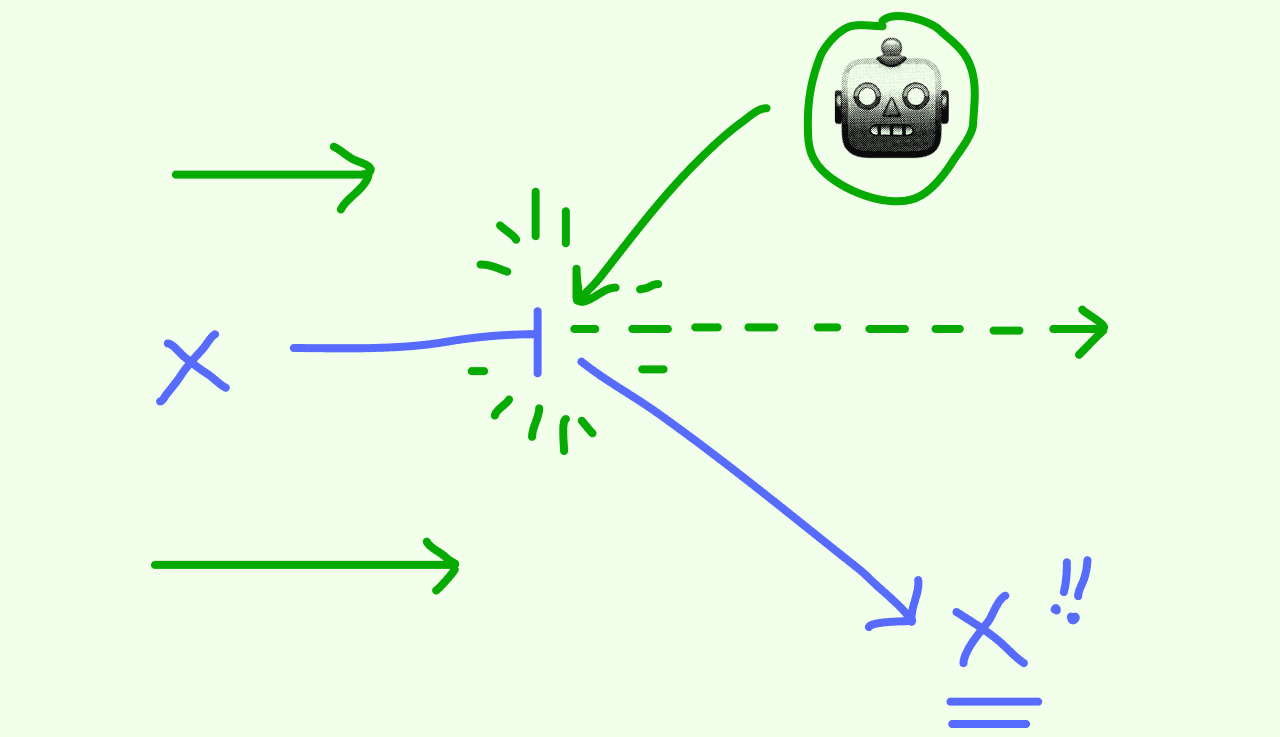
Situation: Prospect says they’re going with a competitor.
While you’re on a call, the prospect mentions a competitor. Now, you’re a tactful salesperson. You’re not going to get worked up. But… you’ve never heard of the competitor.
No worries! You don’t need to frantically look up the tool, and all of its features. The features aren’t what sell it anyway. This is exactly what AI is for. Here’s the play.
The Play:
Step 1: Plug the competitor’s name into AgentGPT with this prompt:
“What are the main reasons customers don’t like this tool?”
Step 2: Within 10 seconds, you’ve scraped the top reasons. Use these points to persuade your prospect on the call.
Take it one step further and use AgentGPT to create autonomous AI agents. It’s like having a smart computer friend that can think for itself and do things without needing someone to tell it what to do!

The Benefit:
This play allows you to stab the pain points of your competitors in seconds without even knowing who they are first. You can appeal to your potential customer by pointing out how your product is better for their specific needs without breaking a sweat.
“With data-driven insights about consumer preferences and behaviors, AI is enabling hyper-personalization in sales methods. Use it better grasp your clients' demands and improve customer satisfaction and sales.”

The Tool:
AgentGPT enables users to create, configure, and deploy autonomous AI agents. An autonomous agent gathers information from its surroundings and independently determines how to connect external stimuli with its actions to achieve specific objectives.
6) The Desire Cheatsheet

Situation: You’ve booked a call, but don’t know much about why your customer is interested.
We all do research before a sales call, that’s just part of the job of a salesperson. The average salesperson spends 14% of their time on research. That’s nearly 6 hours a week! What if you could reclaim even some of that time?
You could use those hours for up-selling and cross-selling instead, right? You’re gonna love this play! We’re calling on the classic AI assistant to speed up your research.
The Play:
Step 1: Use this prompt in ChatGPT:
Topic: Going skiing [← switch for your product or service]
Provide a succinct list of the desires that customers looking to achieve the above topic will have.
Step 2: Customize the prompt with what you know about the customer.
For example, going skiing with a child.
Step 3: Rerun the prompt to get a better idea of why they are interested.
Step 4: Use this information to customize your presentation and call preparation.
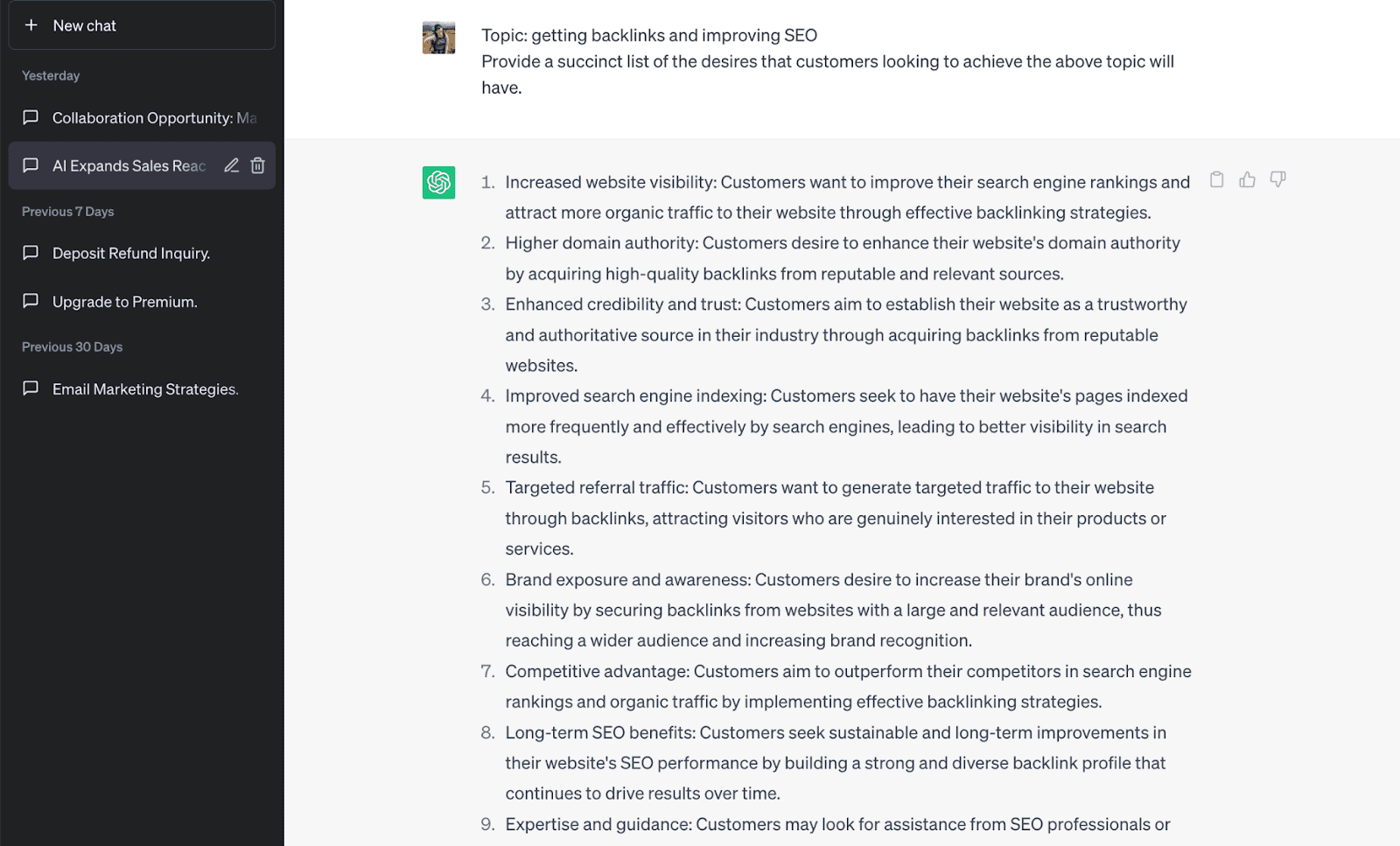
The Benefit:
It's like having a superpower that helps you understand your prospects better and increases your chances of closing deals! You can save time researching your prospects' interests while also having more meaningful conversations.
“ChatGPT is great at writing outlines, first drafts, brainstorming ideas, etc. But don’t take everything generative AI says to be true. It's not. It makes up stuff. It even gets fundamental concepts wrong as well. ALWAYS verify.”

The Tool:
ChatGPT is a chatbot that generates text conversationally. It’s based on an advanced language model that uses AI to generate human-like responses.
7) The Outreach Zipper

Situation: Cold outreach
You won’t land deals without accurate data and personalized follow-ups. But almost half of sales representatives say that their biggest challenge was incomplete data. Plus, follow-ups are time-consuming and take up brain power.
Why not automate at least some of it? Don’t worry. There’s an app for both data transferring and follow-ups! Try this.
The Play:
Step 1: Use LinkedIn or a similar website to identify new leads.
Step 2: Use Magical to transfer their key info into Salesforce or a spreadsheet.
Step 3: Send a cold email as you might usually.
Step 4: Follow up on LinkedIn and use Magical to generate a custom follow-up outreach.
Step 5: Personalize it instantly using Magical.

The Tool:
Magical uses AI to speed up repetitive tasks as you work. It allows you to Supercharge productivity with autocomplete, personalization, and automated copy-and-paste functions.
5 Sales AI Tools Every Account Rep Needs (That You Can Sneak By IT)
You get it by now, right? It’s time to start using AI. But maybe seven plays are one too many, if you’re feeling a bit overwhelmed still – just take it one step at a time. Try adding one of these expert-recommended tools to your sales workflow today.
1. Eleven Labs Prime Voice AI
ElevenLabs aims to convert spoken audio across languages instantly. Prime Voice AI creates spoken audio in various voices and styles. Their speech software is geared toward publishers and creators but can be used in almost any industry. If you’re sick of small talk and ready to give your voice a break, take advantage of this one.
2. One AI Language Studio
What happens when you end a sales call? Do you sit at your desk overthinking everything you said while you go to create their custom proposal? The One AI Language Studio offers over 27 natural language processing functions, including our favorite – a sentiment analysis tool that provides insights into the emotions expressed in a text transcript. Save your brain – try AI.
3. Magical
Do you associate the letters “CRM” with “mind-numbing?” Magical is on a mission to free the global workforce of mundane, soul-crushing tasks. Automagically. The app leverages AI to enhance efficiency during work by accelerating repetitive tasks. It boosts your productivity through autocomplete, personalization, and automated copy-and-paste features.
4. tl;dv
Stop typing during meetings. Get a robot to take notes for you! Tl;dv is redefining the meeting culture by promoting the symbiosis of live collaboration and asynchronous knowledge exchange and enabling instantly shareable meeting insights. They’re assisting you in declining non-essential meeting invites and empowering individuals to catch up on meetings in minutes.
5. AgentGPT
Remember that college intern we talked about? Yeah, the one who scrolls crypto videos on TikTok? This is their replacement. AgentGPT tackles a wide range of tasks across various domains, without requiring any human assistance – aside from setup. The task-driven autonomous AI agent operates directly in your browser. The creators, Reworkd, are on a mission to “make ship happen.”
5 Sales Prompts You’ve Gotta Try (+ Expert Tips)
AI is here to be a powerful assistant to sales reps, but you can’t just treat it like a plug-and-play solution. Lerner warns us, “In the context of prompts, the old adage, "garbage in, garbage out," holds true. Embrace experimentation and keep iterating to improve the results.”
Treat it like your assistant, your sparring partner, your brainstorming buddy. Huang advises, “Tools like ChatGPT are excellent at helping you refine your work. Push yourself to think bigger and more thoroughly with it.” You no longer have to wait for one-on-ones with your manager or pipeline reviews.
Before you dive into our mini prompt library, brush up on these dos and don’ts. ChatGPT is easy to learn, but it’s not without its nuances.
The dos and don’ts of using ChatGPT
We’ve finally reached a place where AI understands our underlying motive. That’s exciting because it allows us to use it to our full advantage. It’s like having an unpaid intern that’s actually efficient. This is something Aadit Sheth, creator of the Neat Prompts newsletter, knows a great deal about.
We have finally reached a place where the AI understands our underlying motive. You CAN be descriptive and share the underlying motives when using ChatGPT. But you want to do 3 things: 1. Be clear. 2. Share an example (if you can). 3. Provide the format you want your answer in.
Aadit’s favorite framework for prompt writing is the CEF framework. It stands for clear, example, format. Each of these things offer small intricacies that AI models will understand. So here are Aadit’s top 5 do’s and don’ts for ChatGPT and other prompt-based AI tools.
Do be clear.
You can be descriptive and share the underlying motives, ChatGPT understands that. Tell it what your company is, and give it your name, your prospect’s name, and info about your prospect. Really, be as detailed as you can. Don’t be afraid to ask it to rewrite the output, but, again, specify why and how you want it to do so.
Do provide an example if you can.
Examples have small intricacies that AI models will understand. It can mimic and reword skillfully. If you’re doing anything more than researching, you might be taking a shot in the dark without an example.
Do specify the format you want your answer in.
Do you want bullet points? Do you want a 10-sentence paragraph? Do you want a tweet? Do you want a video script? Be specific! Otherwise, you’ll get whatever format it wants.
Don’t assume everything it says is true.
It makes up stuff. It even gets fundamental concepts wrong as well. It isn’t factual, so make sure you fact-check everything it says before you share it for client-facing purposes. It’s best for brainstorming, first drafts, simplifying, rewording, outlining, and things like that.
Don’t use it for mathematical calculations.
It will probably get better at this over time. Especially with new plug-ins and internet connectivity. But for now, it will mostly get math wrong. Don’t use it to calculate conversion rates, clicks, sales etc. It will mostly get it wrong.
Don’t feed it sensitive information.
Do not feed ChatGPT any information that isn’t public. Everything you input into ChatGPT is stored in a database and analyzed. So, avoid including physical addresses, email addresses, phone numbers, and other personal information that can’t easily be found publicly on the internet!
Now that you know ChatGPT best practices, here are five prompts you can incorporate into your daily sales process to save time.
1. The Cold Sales Email
Write a concise and informal email to a sales lead from [your name] to [your prospect’s name] using the following information [public information about the prospect and details about you and your company]
While this one may need to be modified in the middle to be a bit more compelling, it’s off to a great start. In combination with the Instant Rapport Builder play, this could easily be a time-saving prompt for any salesperson. Try adding even more details about your prospect and their company to get a more targeted output!

2. The LinkedIn Prospect
Write a cold email and subject line to [prospect’s name], who I just found on LinkedIn. Here’s their summary: [insert their summary]. The email should be from [your name] at [your company].
ChatGPT went beyond cold-prospecting with the information from this LinkedIn profile. It made the prospect feel like it was entering a collaboration where they would be heard, rather than just sold to.

3. The Follow-Up Email
Write a 100-word follow-up email and subject line to Jeremy, who I've just had a call with and is now ready to subscribe to our product. Here's more info about Jeremy: [insert public info]. Here’s more info about me, the sender: [insert your info].
This prompt creates a concise but encouraging email acknowledging the conversation you’ve already had. It keeps you top of mind and maintains a positive image with your prospect. You can easily start with this and customize it even more if you want to.

4. The Ghost
Write a concise, professional sales email with subtle humor and a subject line to a prospect who's ghosting me. Here's more info about the prospect: [insert public info about your prospect]. Here's more info about me, the sender: [insert your info].
For this prompt, we included the LinkedIn summary of my prospect, and ChatGPT delivered a spicy email! “Subtle humor” can have mixed results with ChatGPT, so be prepared to edit. It can come across as too forward, but this is the most personality you’ll probably see from the chatbot. Play around with it!

5. The Research
Topic: [insert your prospect’s industry, job, or other information you’re researching]
Provide a succinct list of the desires that customers looking to achieve the above topic will have.
Speed up the research process so that you can understand your prospects better with this prompt. Dive even deeper by using the follow-up question, “Why would someone like this want to use [whatever you’re selling]?”

6. The Sparring Partner
I need you to build a conversation between two people; one is Rosie, and the other is Ari. Rosie is a business owner with a multimillion-dollar company. Ari is a marketing genius who has honed her skills for the past 15 years. Extra info: Ari has the mindset of Peter in Suits tv show, so she uses Harvey's moves to close Rosie. Now Ari meets for the first time with Rosie to discuss some business. Ari's main goal is to convince Rosie to let him market her company's products. But it's not easy for Ari to convince Rosie because she has a lot of objections. Now Ari needs to answer all of her objections and finally convince Rosie to allow him to do marketing. Now show exactly how this conversation goes from start to end, and after every objection handled by Ari, show which framework Ari used to convince Rosie's objections.
This prompt, from NeatPrompts, generates a concise and formal conversation that reveals where you may come across objections during your sales calls. It also shows which objections it handled in “frameworks” so you can make a quick list for your meeting.

AI is here to stay
You don’t have to Imagine a day when you're no longer bogged down by mind-numbing administrative tasks or endless data entry—because that day is today. Your unpaid intern just became a robot and a data scientist all in one.
It’s high time for the worker’s revolution. The old way of selling isn’t working anymore. You don’t need tech know-how to start using AI. You just need to know which tools to use—and if you don't by now, you should start back at the beginning!
Let's address the elephant in the room. You might’ve been nervous about your job going into this. After all, LinkedIn is making it seem like the AI developers are handing our jobs to robots. AI is a tool meant to enhance your skills, not replace them.
Embrace the opportunity to upskill and evolve alongside AI. Become the master of this technology, and you'll find yourself even more valuable in the ever-changing sales landscape. Sales is ultimately a relationship-based endeavor. Your personal touch and authentic connection with prospects and customers will always be irreplaceable.
It’s up to you to strike the perfect balance between leveraging AI and nurturing those human connections. Just remember, it’s AI, not a mind reader. Keep your prompts clear and concise, and maybe throw in a virtual high-five if it delivers something impressive. AI can't resist a well-timed virtual high-five.
